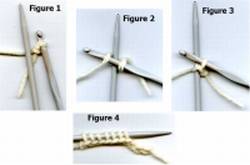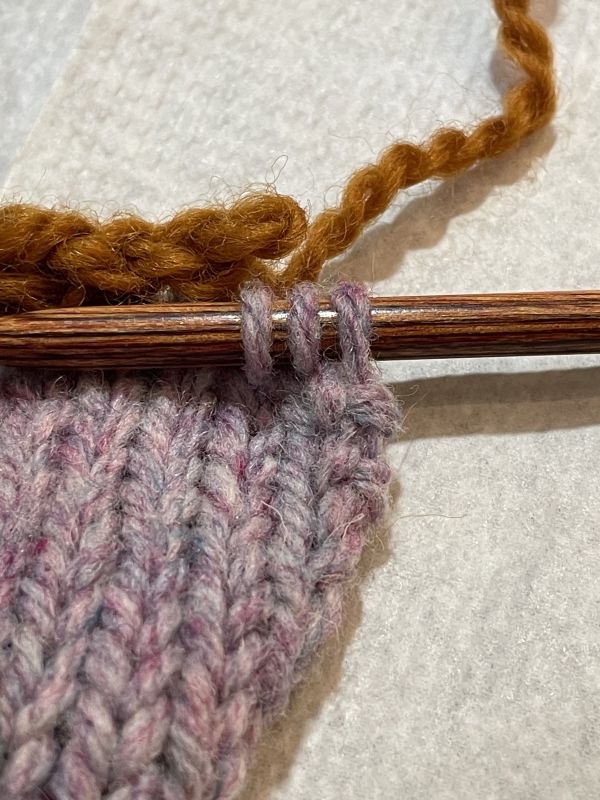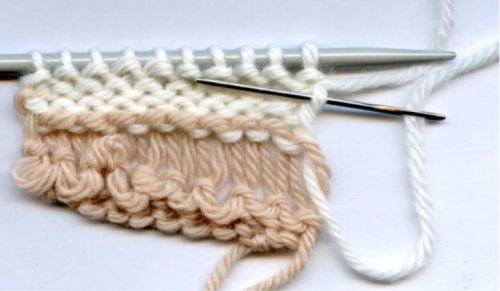- Moebius cast on
When knitting a Moebius, use the Moebius cast-on. Otherwise you will end up with a faux moebius. Find Cat Bordhi’s excellent video here.
—added February 23, 2013
- Picot cast on

This results in a very nice border with picots. Try this example.
- Using a cable cast-on or other knit cast-on, cast on 4 stitches.
- Now we are going to begin a 5-stitch picot. Cast on 5 more stitches. Bind off 5 stitches. (Try the modified conventional bind-off; once learned, it is faster.) Slip the stitch from the right- to the lefthand needle by inserting the lefthand needle in the stitch from front to back.
You now have 4 stitches.
- *Cast on 9 stitches (4 stitches plus the 5 stitches for the picot). Bind off 5 stitches. Slip the stitch from the right- to the lefthand needle by inserting the lefthand needle in the stitch from front to back. You have just added 4 stitches to the total cast on.*
- Repeat between * * until you have 4 stitches less than the total desired.
- Cast on 4 stitches.
—added November 8, 2011 from Lucy Neatby’s Knitting Gems
- Provisional cast on

This is one of the easiest provisional cast ons I have found. Also, it can also be used if you want the cast on edge to match a conventionally bound off edge.
- Using a smooth yarn in a contrasting color, make a slip knot and place it on a crochet hook the same size as the needles. (Figure 1)
- With yarn in back of the knitting needle, bring the hook over the top of the needle (Figure 2), catch the yarn and pull it through the loop on the hook. (Figure 3) Repeat this step until the number of stitches desired has been cast on.
- Chain a few stitches. Cut the yarn and pull through the last chained stitch. When you are ready to unravel the waste yarn, this will be the end that you gently pull to remove the waste yarn.
- Figure 4 shows the completed cast on.
—added December 1, 2011 from Lucy Neatby’s Knitting Gems 4
When picking up a provisional cast on, be sure to pick up the half stitch at the beginning of the cast-on. This will ensure your stitch count
matches your original count.

—added December 21, 2024
- Tubular cast-on for K1, P1, ribbing: This has its own page because the directions includes several images. Click here.
(Printable Page)
- Tubular cast on for Single-Color Double Knitting
- Cast on half the desired number of stitches with a smooth yarn in a contrasting color the same weight as the main color.
- Purl 1 row.
- Knit 1 elongated row: *K 1, wrap the yarn around the right needle twice, repeat from * ending with K1.
- With main yarn, purl 1 row dropping the wrapped yarn.
 To add another loop of main yarn that shows through the elongated stitch, using the beginning tail of the main yarn, complete the stitch by threading it through the first stitch in the row below the needle. This is important if you need an even number of stitches. To add another loop of main yarn that shows through the elongated stitch, using the beginning tail of the main yarn, complete the stitch by threading it through the first stitch in the row below the needle. This is important if you need an even number of stitches. - With main yarn, purl 1 row dropping the wrapped yarn.
- With main yarn, beginning with a knit row, work 3 rows in stockinette stitch.
- 1. Pick up the first purl bump of the main yarn, place it on the left-hand needle and knit it. (Be sure to get that first bump created when you completed the stitch in the prior step.)
2. With yarn forward, slip the next st
3. Repeat steps 1 and 2 to the end of the row.
You have now cast on and are ready to knit the next row: *K1; with yarn forward, sl 1*, repeat between * * across the row.
After working several rows in this manner, remove the waste yarn.
—added January 23, 2016
|

